How to Clean Climbing Shoes? The Ultimate Guide (2024)

Published on: 12/20/2021
We’ve all been there. Your new shoes have finally broken in perfectly, the leather has stretched, and the rubber is still sticky – they’re now a second skin. There’s just one problem… What’s that unholy stink?
Don’t worry, you’re not alone. Rock climbing is a sweaty activity. Even when it’s not especially hot, your feet are going to perspire. To add to the problem, many of us don’t wear socks when we climb, making our shoes absorb all of that moisture.
It’s only a matter of time before dead skin cells build up and lead to bacterial growth. The result of this – smelly climbing shoes. It’s time to figure out how to clean climbing shoes.
Avoid the Funk – Keep Em’ Clean
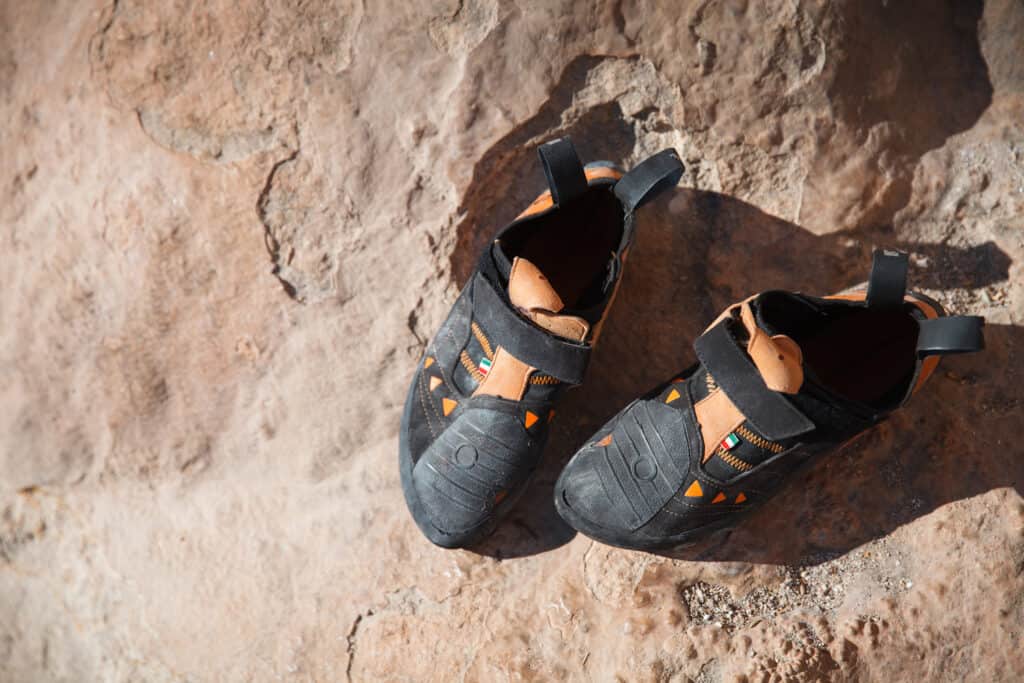
Thankfully, there are a number of ways to combat this problem. We’ve compiled an article with tips on preventing the stink from building up and cleaning climbing shoes once it’s developed. We’ve also included some budget-friendly ways to clean your climbing shoes using household items like baking soda and mild detergent.
But the number one way to keep your climbing shoes from stinking? Assume personal responsibility for their condition from day one – even right after a session. It’s way too easy to leave your wet climbing shoes in the trunk of your hot car after a hard day at the crag.
But that dark, moist environment is the perfect breeding ground for the bacteria that make shoes smell. Let them air dry out of direct sunlight after every session, and your shoes will develop fewer bad smells.
The Number 1 Reason to Keep Climbing Shoes Clean
Cleaning your climbing shoes will make you more popular with other climbers around you and make your gear last longer. But there’s an even more compelling reason to do it. That stink is bacterial/fungal growth. And it’s in direct contact with your skin. It feeds on the waste products that come out of your sweat glands.
Infections
Letting it get out of control can lead to staph infection or athlete’s foot – neither of which are fun to deal with and can keep you away from climbing. Keep your feet clean. And keep those climbing shoes clean too. Both work better when you look after them.
How to Clean Climbing Shoes: 4 Solutions
1. Hit Them With Lysol
This is the preferred method for climbing gyms, bowling alleys, ice rinks, and other places that rent footwear. Establishments with rental shoes deal with all kinds of stinky, nasty feet and know what they’re doing. But like with most methods we list here, timing is essential.
Spraying your climbing shoes down after they’ve sat in a dark, damp closet for a week won’t be nearly as effective as immediately after a climb. The goal is to kill the bacteria/fungus before it can get a chance to develop. Once it’s established, it’s much harder to eliminate. To stay on top of it, apply a light spray after every session. That’s what they do at the local climbing gym.
The Lysol Insert
That said, there is another method using Lysol or a similar product for particularly stinky shoes. Wad some newspaper or paper towels and spray it down with the Lysol. Then place the paper inside the shoes and leave them overnight. If this isn’t enough after 24 hours, you can repeat the process with fresh newspaper and Lysol. Eventually, the evaporating antiseptic should remove the smell from the fabric to some degree.
Alternatively, you can use deodorizers like Banana Boots that are designed specifically for this.
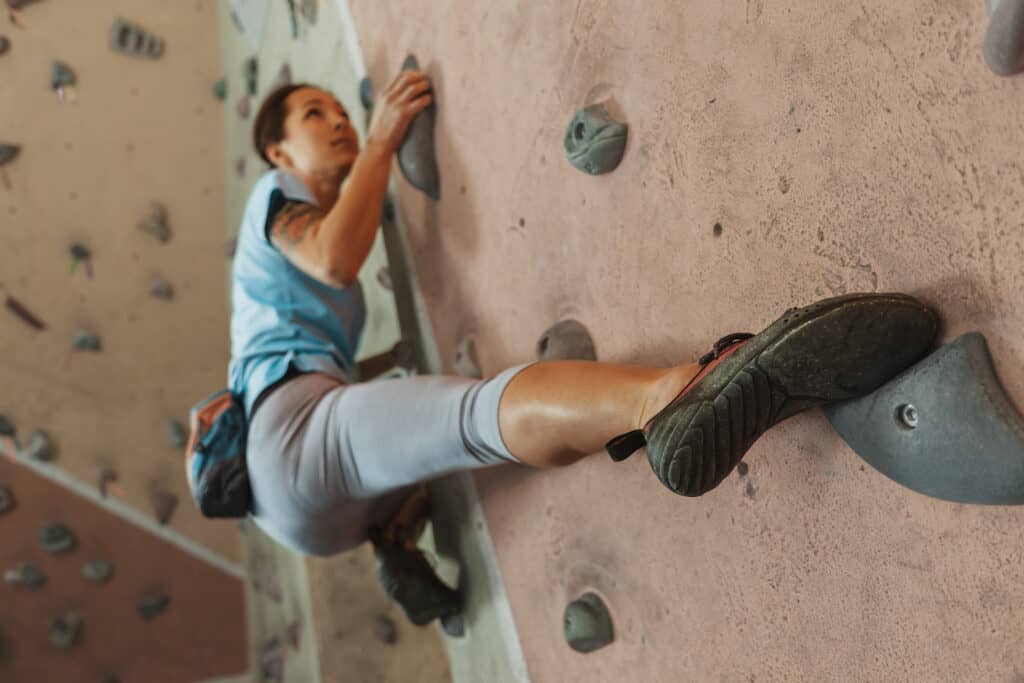
2. Give Them a Hand Wash
First things first. If your climbing shoes don’t smell bad but look dusty, wipe them down with a damp cloth. That is all. There’s no need to expose them to soapy water until it’s absolutely necessary. Only a build of sweat and dead skin can cause bad smells. You don’t need to wash climbing shoes because of dust/dirt.
Secondly, no matter what the tag says, the best way to wash your shoes is to hand wash them. You’ll need a soft brush, some mild soap, lukewarm water, and a basin to do this. The kitchen sink will do if you have nothing else.
Here’s how to wash climbing shoes:
1. Gently Brush and Scrub
Brush as much dirt, pebbles, and debris from your shoes as possible with a dry brush. Turn each climbing shoe upside down and tap out any chalk, dust, or pebbles. Submerge them in warm water in a basin using about a teaspoon of detergent for each shoe. Gently scrub the inside and outside of each climbing shoe, then leave them to soak for up to 1 hour (30-40 minutes is enough for leather shoes – longer is OK for synthetic shoes).
Note: Dirty soles are rarely responsible for the smell, but it’s worth giving them a light scrub now for performance reasons. The rubber used in the soles of your climbing shoes is a big part of why we want only to use a mild detergent when we wash climbing shoes. Anything too harsh could negatively affect the grip of our soles by drying out the rubber.
2. Rinse Until the Water Is Clear
Rinse each shoe in cold water until the water runs clear, then dry with a fan or hairdryer on a cold setting. You can also let them drip dry out of direct sunlight. Some people like to stuff their shoes with newspaper or paper towels to draw out more moisture and avoid shrinking or deforming. Dry the shoes thoroughly before storage.
Tip: If the stink is truly ungodly, try adding a capful of white vinegar to the warm water and detergent mix as you hand wash.

Can you wash climbing shoes in the machine?
If the tag on your climbing shoe says “machine washable,” you can be pretty confident the process won’t destroy it. However, for most climbing shoes, this isn’t an option.
Synthetic climbing shoes are more suitable to be machine washed than leather ones. But hand washing remains an easier and safer option than a machine wash overall.
If you use a washing machine, do it in a low-temperature setting (30°C / 86°F) with a gentle detergent. Never use bleach, and never use a tumble dryer.
3. Use Baking Soda
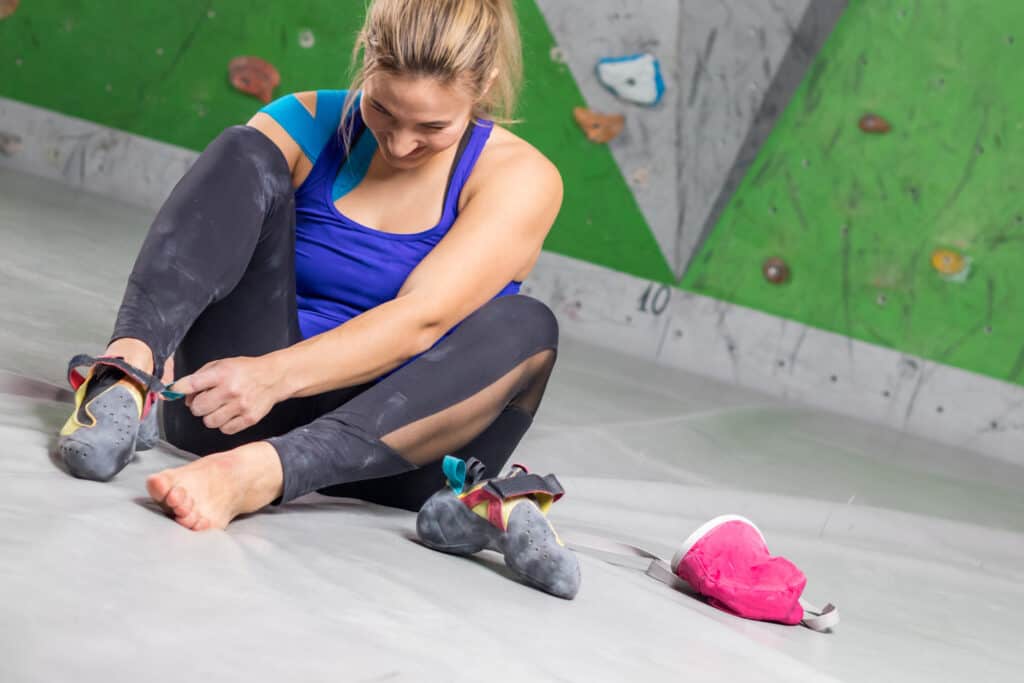
Stinky feet smells are either a form of acidic or alkaline molecule released into the air. Baking powder is amphoteric, meaning it can react with both acidic and alkaline compounds, turning them into much less potent smelling sodium.
To summarize the science part – baking powder can neutralize the stink from your smelly climbing shoes by converting it to salt (1). It’s a handy way to keep your shoes smelling better as it’s a common household item and inexpensive.
Some people lightly dust baking powder inside their shoes after every climb, trying to achieve a thin layer over the surface. This will reduce the smell and dry out the interior of the shoe, making it more difficult for bacteria and fungus to thrive. It will leave a dusty white powder inside your shoe, however. This can turn into a slippery paste after a few minutes of climbing.
If you use this method, try to knock as much powder residue out of your shoes before climbing again. Banging them together should do the trick. Just do it in the parking lot, away from other people.
Others prefer to apply the baking powder after washing the climbing shoes with detergent and warm water. In this case, apply the powder to the wet shoe after you’ve thoroughly rinsed all the soap out. Work the powder in with your soft brush to ensure it penetrates the material. Rinse the shoes until the water runs clear, and all the baking soda is removed. Dry using a fan or hairdryer set to cold.
4. Optional: Rubbing Alcohol
This is more of an “at the crag” type solution. But it does work. Alcohol is a pretty effective disinfectant, and it evaporates fast. This makes it useful for quick disinfection of your shoes after a climb. Mix some alcohol with a small amount of water to gently brush down and clean the outside of the shoe. Lightly spray some alcohol inside the shoe and work it in with a soft brush. Allow each climbing shoe to air dry.
Caution with Leather
This method is effective, but alcohol can rapidly dry out your climbing shoes – especially if they’re leather. This rapid drying process can cause cracking. If you’re concerned about this, have some leather treatment product ready to apply after the shoes have dried. This should mitigate any over-drying problems.
Note: This is not something we’d recommend doing on a fresh pair of new climbing shoes. It’s more of a desperate measure kind of solution for rock climbing camping trips.
Tips For Managing Smelly Climbing Shoes
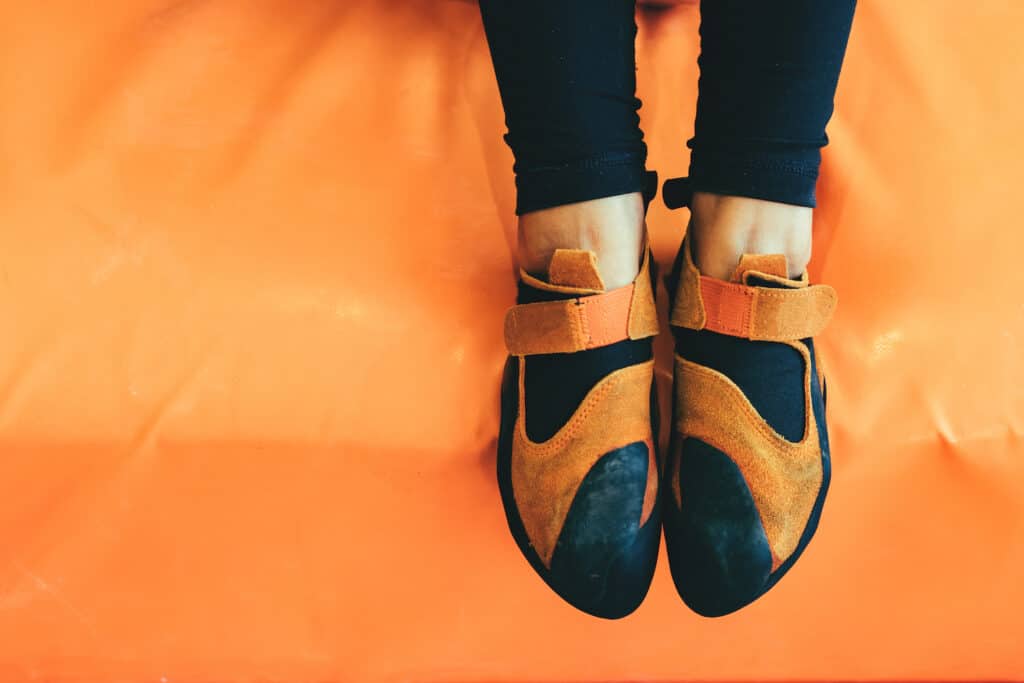
Dryer Sheets
Dryer sheets are absorbent and offer a strong, pleasant smell to compete with the stink from your feet. Stuffing them into a pair of climbing shoes can help for storage. But like we keep saying, make sure the shoes are completely dry before you store them. Once your climbing session is finished, allow shoes to dry in fresh air before packing them with the dryer sheets and moving them to a closet.
This is more of a management technique than a solution. It doesn’t attack the problem at its root. However, if you combine it with other practices on our list, your housemates will thank you. Spraying your shoes with Lysol (or a similar antiseptic spray) before packing them with the dryer sheets should do a better job overall.
Activated Charcoal Inserts
Charcoal is well known for its ability to absorb impurities and bad smells. Some hiking/climbing-specific products use sustainable bamboo charcoal, but any product with activated charcoal will absorb some of the bad smells in shoes. Many climbers buy these insoles/inserts and leave them in their shoes whenever they’re not in use.
Like the dryer sheet method, this only treats the symptoms of the stink. Combine it with another method for maximum effect.
Dust Down Your Feet
We chalk our hands to reduce sweating, so why not our feet? The answer – many people do. Some climbers use regular chalk on their feet before putting on their climbing shoes. Others use liquid chalk, which is generally more effective.
Foot Specific Powder
We’d say you’re even better off using a foot-specific powder that you can buy for cheap at the drugstore. Many of these foot care products have anti-fungal and anti-bacterial agents in them. They’ll reduce sweating and prevent infection.
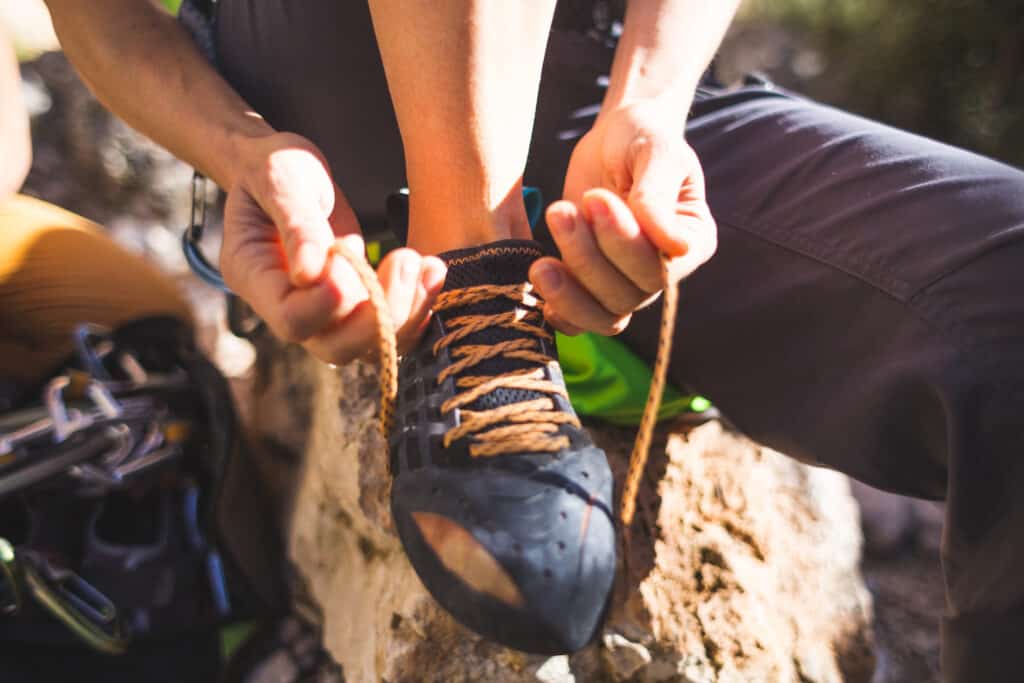
Let Your Shoes Breathe
Carrying your climbing shoes in a mesh bag or clipped to the outside of your backpack is recommended. This helps your shoes air dry as you go home after a session. Putting them directly into a closed bag while they are still soaked with your sweat is a terrible idea. The material will continue to absorb moisture, and more bacteria will develop.
If you’re on public transport and this isn’t an option, make sure to take them out, and air dry them as soon as possible. Your shoes will only develop smells while wet.
Wash Your Feet
Seems like a pretty obvious one. But we suggest you wash your feet immediately before putting your shoes on every single time. The cleaner your feet are when they go in, the cleaner your shoes are when they come out. Bacteria builds up on our skin throughout the day. Starting with fresh feet means there’s less of a chance for it to build up inside your shoe.
Put Them in the Freezer
Putting your shoes in the freezer will halt the development of new bacteria but won’t kill existing cells. This means it can be effective at preventing the build-up of smell. But it’s not a solution to stinky shoes. Also, no one we’ve ever lived with would be cool with us putting our climbing shoes in the freezer.
Wear Socks
OK – socks aren’t a good idea for an ultimate rock climbing performance. But if keeping the stink down is a priority, they can make a huge difference. By absorbing a lot of the sweat and dead skin cells, socks help to prevent the build of bacteria that causes your shoes to stink in the first place.
References
The Science of Baking Soda
Alice Graves and Kate Qualmann (Aug 2018)
American Chemical Society
https://axial.acs.org/cross-disciplinary-concepts/the-science-of-baking-soda
Is it Possible to Sanitize Athletes’ Shoes?
Messina et al. (2015). Journal of Athletic Training.
https://www.ncbi.nlm.nih.gov/pmc/articles/PMC4495438/
